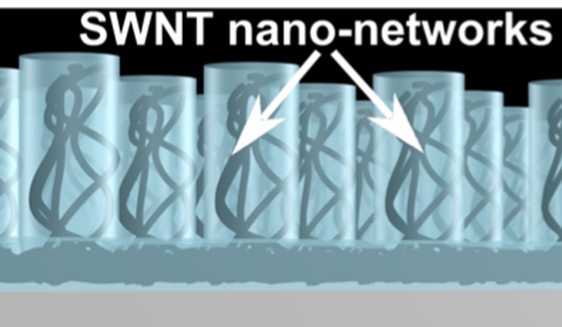Ordered carbon-nanotube design may increase conductivity of solar cells by 100 million times
April 2, 2014

Structured single-wall carbon nanotube-based networks optimized for higher-conductivity and lower-cost solar cells (credit: Umeå University)
Controlled placement of carbon nanotubes in nanostructures could result in a huge boost in electronic performance in photovoltaic solar cells, researchers at Umeå University in Sweden have discovered.
KurzweilAI has reported on a number of recent research projects using carbon nanotubes as a replacement for silicon to improve the performance of solar cells. However, according to Umeå University researchers, the projects have found that the nanotubes are difficult to form into well-ordered networks; they tend to be randomly arranged.
In the new study, published in Advanced Materials, the researchers were able to engineer the nanotubes into complex network architectures with controlled nanoscale dimensions inside a polymer matrix. That structure allows for better conductivity (lower loss of power) and reduction of the number of high-cost nanotubes needed.

Carbon nanotube structures in solar-cell film. Left: traditionally mixed composite film made of random single-wall carbon nanotubes (SWNTs). Right: nano-engineered SWNT network. Dotted lines represent semiconducting nanotubes and thicker continuous lines represent metallic nanotubes. (Credit: David R. Barbero et al./Advanced Materials)
“We have found that the resulting nano networks possess exceptional ability to transport charges, up to 100 million times higher than previously measured carbon nanotube random networks produced by conventional methods,” says David Barbero, project leader and assistant professor at the Department of Physics at Umeå University.
“This innovation has direct implications for the next generation of carbon-based solar cells, which use carbon nanotubes and other carbon materials (graphene, semi-conducting polymers, etc.),” Barbero told KurzweilAI. “That’s because the new nano-engineered networks show much increased charge transport compared to commonly used networks today. These new nano-networks could also in principle be advantageously used in any nanocomposite material where efficient charge transport is required, and where low amounts of nanotubes are necessary.
“This new architecture enables a higher degree of interconnection between nanotubes and more robust charge transport pathways in the device,” he explained. “This is expected to increase device efficiency, but also to reduce materials costs because at least 100 times less nanotubes are necessary to form efficient charge transport networks.”
Barbero could not predict when this new technology might go into production, but hinted that “this field is moving fast and things can happen quickly, so stay tuned.”
In a previous study (Applied Physics Letters, Volume 103, Issue 2, 021116 (2013)) the Barbero’s team demonstrated that the nanotubes can also be formed into thin, flexible, transparent electrodes, allowing for high-performance flexible solar cells.
Abstract of Advanced Materials paper
We demonstrate a simple and controllable method to form periodic arrays of highly conductive nano-engineered single wall carbon nanotube networks from solution. These networks increase the conductivity of a polymer composite by as much as eight orders of magnitude compared to a traditional random network. These nano-engineered networks are demonstrated in both polystyrene and polythiophene polymers.